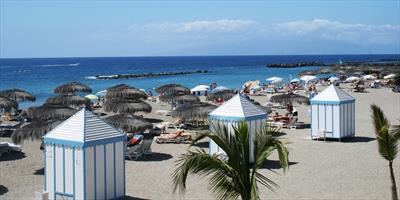Location
Together with the neighbouring Gran Canaria, Tenerife forms the centre of the Canary Islands. Tenerife is located 60 km to the west-northwest of Gran Canaria. Nearby islands to the west of Tenerife are La Gomera (28 km) and La Palma (84 km).
The coordinates of Tenerife are 28°16′ N 16°36′ W.
Surface and Landscape
Surface Area and Shape
Tenerife is the largest of all Canary Islands and has a surface area of 2,034 km². It has triangular shape with the base of the triangle being formed by the west coast and a narrower strip of land running to the northeast.
Tenerife is more than 80 km long (from the base to the top of the triangle) and as much as 50 km wide (at its widest point crossing the peak of the Teide close to the west coast).
Tenerife’s Highest Mountain: Pico del Teide
The dominant part of Tenerife’s surface and one of the symbols of Canary Islands is Pico del Teide, a volcano holding several superlatives.
- With its 3,718 m Mount Teide is the highest mountain of Tenerife, Canary Islands and the whole Spain (its height exceeds all mountains in both the Pyrenees and Sierra Nevada).
- It is also the highest mountain of the European Union outside the Alps.
- Teide is also the world’s third largest volcano when measured from its base (the peak of the Teide is 7,500 m above its base at the bottom of the Atlantic).
Due to its high altitude, the peak of Mount Teide is covered with snow in winter, though people are swimming in the sea just few kilometres from it.
Teide National Park and Teide Cable Car
The area surrounding Pico del Teide is protected as the Teide National Park (Parque Nacional del Teide) and offers beautiful sceneries and panoramic views of the whole Tenerife and the nearby islands. There is also a cable car which can get you close to the peak. Climbing all the way to the peak is possible and not that difficult, but to protect the unique environment the number of visitors is restricted and a permit is required (you must get it in advance).
The Diverse Landscape of Tenerife
The landscape of Tenerife is not limited to the super-high volcano. In fact Tenerife has many different faces and both the scenery and the climate vary across the island. Besides the Teide there are other pieces of volcanic landscape, as well as almost desert areas. You can also find deep valleys, mountain ranges, or the tall cliffs, Acantilados de Los Gigantes (Cliffs of the Giants).
While the east and south of Tenerife are quite arid, the north coast gets more rain, as the clouds coming from the ocean are often stopped by the Teide. As a result, the north coast may be less ideal for the beach vacation than the south, but it provides some beautiful views and wild nature.
Population
The total population of Tenerife accounts for almost 900,000 – slightly more than the population of Gran Canaria according to most sources. These two islands together represent more than 80% of all Canary Islands inhabitants and they are the places where the most of the locals’ life is going on (and most of the tourism, too).
Largest Cities in Tenerife
The majority of the population on Tenerife is concentrated in the northeast of the island in or near two big cities very close to one another: Santa Cruz de Tenerife (population of 222,000) and San Cristobal de la Laguna (137,000), the latter commonly called just La Laguna.
Santa Cruz de Tenerife
Santa Cruz de Tenerife is the capital of Tenerife and also the capital of the province bearing the same name. The Province of Santa Cruz de Tenerife includes the islands of Tenerife, La Palma, La Gomera, and El Hierro.
Santa Cruz de Tenerife is the second largest city in the Canary Islands and it shares the status of the capital city of Canary Islands with Las Palmas de Gran Canaria.
Other Municipalities on Tenerife
There are a total of 31 municipalities on Tenerife (sorted in alphabetical order):
- Adeje
- Arafo
- Arico
- Arona
- Buenavista del Norte
- Candelaria
- Fasnia
- Garachico
- Granadilla de Abona
- La Guancha
- Guia de Isora
- Guimar
- Icod de los Vinos
- La Matanza de Acentejo
- La Orotava
- Puerto de la Cruz
- Los Realejos
- El Rosario
- San Cristobal de La Laguna
- San Juan de la Rambla
- San Miguel de Abona
- Santa Cruz de Tenerife
- Santa Ursula
- Santiago del Teide
- El Sauzal
- Los Silos
- Tacoronte
- El Tanque
- Tegueste
- La Victoria de Acentejo
- Vilaflor
Only three of them don’t have access to the sea (El Tanque, Tegueste, and Vilaflor). The municipality covering the largest surface area (including the most of the Teide National Park and Mount Teide itself) is La Orotava.
The area of Tenerife is often divided in three zones:
- Zona Metropolitana (the area around the biggest cities)
- Zona Norte (the north coast)
- Zona Sur (the south and southwest coast)
